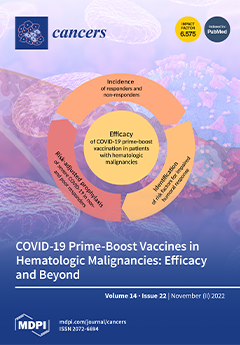The human UDP-glycosyltransferase (UGTs) superfamily has a critical role in the metabolism of anticancer drugs and numerous pro/anti-cancer molecules (e.g., steroids, lipids, fatty acids, bile acids and carcinogens). Recent studies have shown wide and abundant expression of
UGT genes in human cancers. However,
[...] Read more.
The human UDP-glycosyltransferase (UGTs) superfamily has a critical role in the metabolism of anticancer drugs and numerous pro/anti-cancer molecules (e.g., steroids, lipids, fatty acids, bile acids and carcinogens). Recent studies have shown wide and abundant expression of
UGT genes in human cancers. However, the extent to which
UGT genes acquire somatic mutations within tumors remains to be systematically investigated. In the present study, our comprehensive analysis of the somatic mutation profiles of 10,069 tumors from 33 different TCGA cancer types identified 3427 somatic mutations in
UGT genes. Overall, nearly 18% (1802/10,069) of the assessed tumors had mutations in
UGT genes with huge variations in mutation frequency across different cancer types, ranging from over 25% in five cancers (COAD, LUAD, LUSC, SKCM and UCSC) to less than 5% in eight cancers (LAML, MESO, PCPG, PAAD, PRAD, TGCT, THYM and UVM). All 22
UGT genes showed somatic mutations in tumors, with UGT2B4, UGT3A1 and UGT3A2 showing the largest number of mutations (289, 307 and 255 mutations, respectively). Nearly 65% (2260/3427) of the mutations were missense, frame-shift and nonsense mutations that have been predicted to code for variant UGT proteins. Furthermore, about 10% (362/3427) of the mutations occurred in non-coding regions (5′ UTR, 3′ UTR and splice sites) that may be able to alter the efficiency of translation initiation, miRNA regulation or the splicing of UGT transcripts. In conclusion, our data show widespread somatic mutations of
UGT genes in human cancers that may affect the capacity of cancer cells to metabolize anticancer drugs and endobiotics that control pro/anti-cancer signaling pathways. This highlights their potential utility as biomarkers for predicting therapeutic efficacy and clinical outcomes.
Full article






